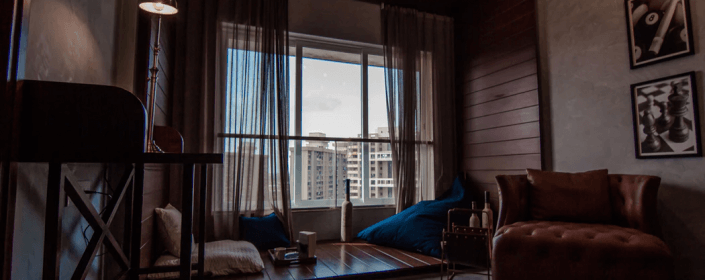A Look at the Various Types of Window Designs and Materials to Suit a Building’s Form and Function
Windows have both functional and aesthetic purposes. They provide buildings with natural light and air circulation, while also adding to the architectural style of a building.
However, window design is continuously changing and has evolved a lot since the historic window styles of centuries past. Even window materials have changed from stones to the modern-day glass windows.
To give you a look into the modern window industry standards and the most commonly used window designs, as an architect, here is all of the most essential information you need to know about windows.
Operating Window Systems
Windows are often categorized by their operating systems—or lack thereof.
Fixed Windows
Also known as a picture window, a fixed window does not open and is non-operational. Fixed windows are designed to maximize the amount of natural light coming in while also providing an unobstructed view of the outdoors.
Sash Windows
A sash is a window panel that can slide up and down to open and close. Sash windows can be single-hung with a fixed top sash and an operable bottom sash, or double-hung with two operable sashes.
Double-hung windows are often preferred over single-hung windows because they allow for better air circulation and are especially cooling during warm weather.
Casement Windows
Casement windows have hinges on one side and swing open with the use of a crank mechanism. Awning windows are a type of casement window that is hinged at the top and swings outward, forming a kind of awning that protects the interior from rain.
Hopper windows are hinged at the bottom and swing inwards, and are commonly used in basements.
Slider Windows
Slider windows usually consist of one fixed window and one operable window that slides horizontally on a track. These windows provide excellent cross ventilation in buildings and are common in modern designs.
Skylights
Skylights are windows that are installed in the ceiling and roof of a building and are ideal for adding natural light in areas with limited wall space.
Skylights can be fixed or operable for increased ventilation. And they can have manual crank mechanisms or automatic remote-controlled operating mechanisms.
Custom Windows
Custom windows can come in many different design options. Architectural windows are an example of custom windows since they are specifically designed to match or complement the architecture of a building.
Aesthetics: Components of Beautiful Windows
Beautiful windows are designed with more details than a typical pane of glass, such as:
Texture
Glass can be finished with various textures for visual depth and different levels of transparency. Thicker glass can also be molded into patterns and shapes.
Acid Etching
Applying acid to glass will etch the surface and create a decorative pattern on your windows.
Opacity
Windows come in various opacities depending on whether you want direct or diffuse light. Different surface treatments are applied to glass to create transparent, translucent, or opaque windows.
Reflectivity
Windows can have a reflective or metallic glass coating to create one-way visibility. Along with adding a contemporary appearance to windows, the reflectivity provides privacy, reduces interior glare, and can prevent solar heat gain for windows exposed to prolonged, direct sunlight.
Materials and Performance
Windows come in a variety of materials, each with their own performance benefits.
Wood
Wood frames are higher maintenance than vinyl and fibreglass frames, and can warp with temperature fluctuations. But a benefit of wood frames is that they create a beautiful, warm aesthetic to a building’s interior and exterior.
Vinyl
Made primarily from PVC (polyvinyl chloride), vinyl window frames are extremely durable and low-maintenance, with excellent insulating properties.
Fibreglass
Fibreglass window frames are made out of glass fibres and resin, two materials that do not contract easily with temperature fluctuations. Fibreglass windows are becoming more popular in the window industry due to their high level of durability.
Aluminum
On its own, aluminum does not have the best insulating properties. But when paired with insulation products, aluminum frames are ideal for slim, modern profiles. These windows are strong and low-maintenance and are often used for framing large picture windows.
Glass
There are various types of glass used in windows, and the type you choose will depend on its purpose.
[su_list icon=”icon: chevron-right” icon_color=”#EC3826″]
- Float Glass—a sheet of glass made by floating molten glass on a bed of molten metal. This manufacturing process creates smooth panes with even thickness. Float glass also has structural flexibility since it can be bent and shaped into various forms.
- Low Emissivity (Low-E) Glass—has a thin, transparent coating of thermally-reflective material that reflects the sun’s infrared light and reduces the amount of heat energy that passes through the glass. Along with keeping heat out, this glass also reflects heat into a building to prevent heat loss in winter. Low-e glass is especially popular for residential windows.
- Insulated Glass Unit (IGU)—also known as double-pane and triple-pane, or double-glazed and triple-glazed windows, these windows have two or three panes of glass separated by spaces filled with air or inert insulating gas, such as argon. IGUs often use a desiccant to remove humidity and prevent condensation. And the glass is also tempered or laminated for additional strength and security.
- Safety Glass—is glass that is less likely to break or be a safety hazard if it is broken. Examples of safety glass include wired glass, tempered glass, and laminated glass. Safety glass is often used for commercial windows to add extra security to a storefront.
[/su_list]
Energy Efficiency
Window glass is also rated for its energy efficiency. Two examples of glass energy performance ratings include:
[su_list icon=”icon: chevron-right” icon_color=”#EC3826″]
- Visible Light Transmittance (VLT)—the amount of transmitted visible light that passes through a windowpane. A high VLT rating is essential for maximizing the amount of natural light in a building (and thus reducing the amount of energy used to power artificial light).
- Solar Heat Gain Coefficient (SHGC)—the fraction of solar radiation transmitted through window panes expressed as a number between 0 and 1. The lower the number, the less solar heat the glass transfers.
[/su_list]
Storm windows also improve the energy efficiency of a home by adding a layer of protection from the elements.
Quadruple-Glazed Windows
While triple-glazed windows are the leading type of insulating window these days, window manufacturers are now designing quadruple-glazed windows for even more insulation.
The fourth pane of glass adds an extra layer of protection from the exterior temperatures, making these uber-insulating windows ideal for cold climates. But keep in mind that the extra pane of glass does make the window unit heavier, so installation can be more taxing. However, window manufacturers are sure to come up with new, sleeker, lighter designs in the future.
For help choosing the best windows for your building needs, refer back to this guide and contact your local window manufacturers.


